View in other NatureServe Network Field Guides
NatureServe
Montana
Utah
Wyoming
Idaho
Wisconsin
British Columbia
South Carolina
Yukon
California
New York
Ottoe Skipper - Hesperia ottoe
General Description
{From Ferris and Brown 1981; Scott 1986; Layberry et al. 1998; Opler and Wright 1999; Glasberg 2001] Forewing 1.6-1.7 cm. Large. Uppersurface with extensive tawny orange and diffuse dark border (more extensive in females, giving a dull brown apearance), male forewing stigma with black gray felt; undersurface of hindwing yellow-orange, without median chevron of white spots, sometimes with a faint paler postmedian area.
Phenology
One flight, late June through July, June in Kansas and Missouri (Scott 1986). June to early August (Glassberg 2001). Late June through July in the Rocky Mountain states (Ferris and Brown 1981). Late June to late July in north-central Nebraska (Dankert and Nagel 1988), mid-June to early August in North Dakota (McCabe and Post 1976).
Diagnostic Characteristics
Best determined from similar species by large size, earlier flight period, uppersurface extensive tawny orange and diffuse dark border, male forewing stigma with black or gray felt, undersurface of hindwing yellow-orange, without median chevron of white spots.
Species Range
Montana Range
Range Descriptions
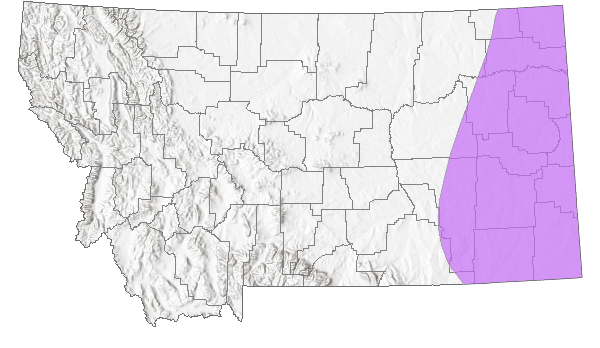
 Native
Native
Range Comments
Southeastern Montana, western North Dakota, southern Manitoba south to central Colorado and northern Texas, east to central Illinois, southwestern Michigan, Nebraska, Kansas (Scott 1986; Layberry et al. 1998; Opler and Wright 1999; Glassberg 2001); below 1920 m elevation in the Rocky Mountain states (Ferris and Brown 1981). In Montana, reported from at least seven far-eastern counties, west as far as Rosebud County (Kohler 1980; Stanford and Opler 1993; FLMNH Lepidopterists' Society), to about 780 m elevation. Rare to uncommon (Glassberg 2001).
Observations in Montana Natural Heritage Program Database
Number of Observations: 2
(Click on the following maps and charts to see full sized version)
Map Help and Descriptions
Relative Density

Recency
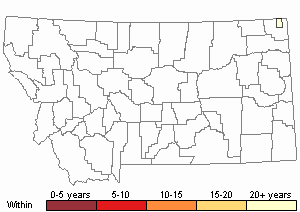
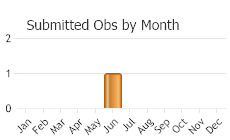
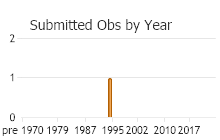
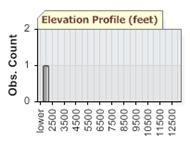 (Observations spanning multiple months or years are excluded from time charts)
(Observations spanning multiple months or years are excluded from time charts)
Migration
Non-migratory. Marked adults in Minnesota moved mean straight-line distances of up to 250 m over 7 days (Dana 1991).
Habitat
Tall-grass to mixed-grass prairie, prairie ridgetops, dry fields, riparian woodland clearings (Ferris and Brown 1981; Scott 1986; Dankert and Nagel 1988; Dana 1991; Layberry et al. 1998; Opler and Wright 1999; Glassberg 2001; Swengel and Swengel 2015). Habitat in Montana not described but probably similar.
Food Habits
Larval food plants are grasses, including Andropogon (multiple species), Bouteloua (multiple species), Bromus, Dichanthelium, Leptoloma, Panicum, and Sporobolis, Poa in captivity; also possibly sedge (Carex) (Ferris and Brown 1981; Scott 1986, 1992, 2006; Dana 1991; Layberry et al. 1998). Adults feed on flower nectar (including Asclepias, Astragalus, Carduus, Cirsium, Cleome, Dalea, Echinacea, Heterotheca, Lactuca, Liatris, Lobelia, Monarda, Oxytropis, Phlox, Solidago, Trifolium, Verbena) and mud (Dana 1981, 1991; Swengel and Swengel 1999; Scott 2014).
Reproductive Characteristics
Females lay eggs singly on host plant leaves, sometimes nearby on forbs (especially Echinacea angustifolia) (Dana 1981, 1991; Scott 1986, 1992, 2006). Eggs hatch 12-13 days post egg-laying (depending on temperature), develop in captivity to L4 instar in 41-94 days post egg-hatch (depending on temperature), overwinter (enter diapause) as L4 (sometimes L5) instar, exit diapause and develop to L5 instar and pupae in about 25-38 days, adults eclose (emerge from pupae) in about 12-22 days (Scott 1979, 1986, 1992, 2006; Dana 1991). Larvae eat host plant leaves (drop to ground and locate nearby host plant if egg deposited on non-host plant forb), early instars build silk-tied leaf-tube nest, move in late summer as L3 or L4 instars to buried shelters to overwinter, pupate in buried shelter following diapause (Scott 1986; Dana 1991). Males perch throughout the day, mainly on flowers near host plants (sometimes bare ground, low plants) on slopes and flats, sometimes patrol, awaiting, or searching for, passing females (Scott 1975b, 1982, 1986; Dana 1991).
Management
Populations of this skipper should be conserved wherever found. Care should be taken in habitat management. Use of fire as a tool should be discouraged (Opler et al. 2010)
Stewardship Responsibility
Threats or Limiting Factors
Conversion of tall-grass prairie to agricultural use has greatly reduced the habitat and numbers of the Ottoe Skipper.
References
- Literature Cited AboveLegend:
 View Online Publication
View Online Publication Dana, R. P. 1981. An Unusual Oviposition Substrate for Hesperia Ottoe (Hesperiidae) in Southwestern Minnesota. J. Lepidopt. Soc. 35(1):77-78.
Dana, R. P. 1981. An Unusual Oviposition Substrate for Hesperia Ottoe (Hesperiidae) in Southwestern Minnesota. J. Lepidopt. Soc. 35(1):77-78. Dana, R. P. 1991. Conservation Management of the Prairie Skippers H. Dacotae and H. Ottoe. Station Bulletin 594-1991. Minnesota Agricultural Experiment Station. Univ. Of Minnesota, St. Paul, Mn. 63 Pp.
Dana, R. P. 1991. Conservation Management of the Prairie Skippers H. Dacotae and H. Ottoe. Station Bulletin 594-1991. Minnesota Agricultural Experiment Station. Univ. Of Minnesota, St. Paul, Mn. 63 Pp. Dankert, N.E. and H.G. Nagel. 1988. Butterflies of the Niobrara Valley Preserve, Nebraska. Transactions of the Nebraska Academy of Sciences 16:17-30.
Dankert, N.E. and H.G. Nagel. 1988. Butterflies of the Niobrara Valley Preserve, Nebraska. Transactions of the Nebraska Academy of Sciences 16:17-30. Ferris, C.D. and F.M. Brown (eds). 1981. Butterflies of the Rocky Mountains. Univ. of Oklahoma Press. Norman. 442 pp.
Ferris, C.D. and F.M. Brown (eds). 1981. Butterflies of the Rocky Mountains. Univ. of Oklahoma Press. Norman. 442 pp. Glassberg, J. 2001. Butterflies through Binoculars: A Field Guide to the Butterflies of Western North America. Oxford University Press.
Glassberg, J. 2001. Butterflies through Binoculars: A Field Guide to the Butterflies of Western North America. Oxford University Press. Kohler, S. 1980. Checklist of Montana Butterflies (Rhopalocera). Journal of the Lepidopterists' Society 34(1): 1-19.
Kohler, S. 1980. Checklist of Montana Butterflies (Rhopalocera). Journal of the Lepidopterists' Society 34(1): 1-19. Layberry, R.A., P.W. Hall, and J.D. LaFontaine. 1998. The Butterflies of Canada. University of Toronto Press. 280 pp. + color plates.
Layberry, R.A., P.W. Hall, and J.D. LaFontaine. 1998. The Butterflies of Canada. University of Toronto Press. 280 pp. + color plates. McCabe, T.L. and R.L. Post. 1976. North Dakota butterfly calendar (including possible strays). Journal of Research on the Lepidoptera 15:93-99.
McCabe, T.L. and R.L. Post. 1976. North Dakota butterfly calendar (including possible strays). Journal of Research on the Lepidoptera 15:93-99. Opler, P.A. and A.B. Wright. 1999. A field guide to western butterflies. Second edition. Peterson Field Guides. Houghton Mifflin Company, Boston, Massachusetts. 540 pp.
Opler, P.A. and A.B. Wright. 1999. A field guide to western butterflies. Second edition. Peterson Field Guides. Houghton Mifflin Company, Boston, Massachusetts. 540 pp. Opler, P.A., K. Lotts, and T. Naberhaus, coordinators. 2010. Butterflies and moths of North America. Big Sky Institute, Bozeman, MT. Available at: www.butterfliesandmoths.org (Accessed 15 June 2015).
Opler, P.A., K. Lotts, and T. Naberhaus, coordinators. 2010. Butterflies and moths of North America. Big Sky Institute, Bozeman, MT. Available at: www.butterfliesandmoths.org (Accessed 15 June 2015). Scott, J.A. 1975b. Mate-locating behavior of western North American butterflies. Journal of Research on the Lepidoptera 14:1-40.
Scott, J.A. 1975b. Mate-locating behavior of western North American butterflies. Journal of Research on the Lepidoptera 14:1-40. Scott, J.A. 1979. Hibernal diapause of North American Papilionoidea and Hesperioidea. Journal of Research on the Lepidoptera 18(3): 171-200.
Scott, J.A. 1979. Hibernal diapause of North American Papilionoidea and Hesperioidea. Journal of Research on the Lepidoptera 18(3): 171-200. Scott, J.A. 1986. The butterflies of North America: a natural history and field guide. Stanford University Press, Stanford, California.
Scott, J.A. 1986. The butterflies of North America: a natural history and field guide. Stanford University Press, Stanford, California. Scott, J.A. 1992. Hostplant records for butterflies and skippers (mostly from Colorado) 1959-1992, with new life histories and notes on oviposition, immatures, and ecology. Papilio new series #6. 185 p.
Scott, J.A. 1992. Hostplant records for butterflies and skippers (mostly from Colorado) 1959-1992, with new life histories and notes on oviposition, immatures, and ecology. Papilio new series #6. 185 p. Scott, J.A. 2006. Butterfly hostplant records, 1992-2005, with a treatise on the evolution of Erynnis, and a note on new terminology for mate-locating behavior. Papilio new series #14. 74 p.
Scott, J.A. 2006. Butterfly hostplant records, 1992-2005, with a treatise on the evolution of Erynnis, and a note on new terminology for mate-locating behavior. Papilio new series #14. 74 p. Scott, J.A. 2014. Lepidoptera of North America 13. Flower visitation by Colorado butterflies (40,615 records) with a review of the literature on pollination of Colorado plants and butterfly attraction (Lepidoptera: Hersperioidea and Papilionoidea). Contributions of the C.P. Gillette Museum of Arthopod Diversity. Fort Collins, CO: Colorado State University. 190 p.
Scott, J.A. 2014. Lepidoptera of North America 13. Flower visitation by Colorado butterflies (40,615 records) with a review of the literature on pollination of Colorado plants and butterfly attraction (Lepidoptera: Hersperioidea and Papilionoidea). Contributions of the C.P. Gillette Museum of Arthopod Diversity. Fort Collins, CO: Colorado State University. 190 p. Shull, E. M. 1987. The butterflies of Indiana. Publication by Indiana Academy of Science. Indiana University Press, Bloomington/Indianapolis. 262 pp.
Shull, E. M. 1987. The butterflies of Indiana. Publication by Indiana Academy of Science. Indiana University Press, Bloomington/Indianapolis. 262 pp. Stanford, R.E. and P.A. Opler. 1993. Atlas of western USA butterflies: including adjacent parts of Canada and Mexico. Unpubl. Report. Denver and Fort Collins, Colorado 275 pp.
Stanford, R.E. and P.A. Opler. 1993. Atlas of western USA butterflies: including adjacent parts of Canada and Mexico. Unpubl. Report. Denver and Fort Collins, Colorado 275 pp. Swengel, A.B and S.R. Swengel. 2015. Grass-skipper (Hesperiinae) trends in midwestern USA grasslands during 1988-2013. Journal of Insect Conservation 19:279-292.
Swengel, A.B and S.R. Swengel. 2015. Grass-skipper (Hesperiinae) trends in midwestern USA grasslands during 1988-2013. Journal of Insect Conservation 19:279-292. Swengel, A.B. and S.R. Swengel. 1999. Observations of prairie skippers (Oarisma poweshiek, Hesperia dakotae, H. leonardus pawnee, and Atrytone arogos iowa)(Lepidoptera:Hesperiidae) in Iowa, Minnesota, and North Dakota during 1988-1997. Great Lakes Entomologist 32:267-292.
Swengel, A.B. and S.R. Swengel. 1999. Observations of prairie skippers (Oarisma poweshiek, Hesperia dakotae, H. leonardus pawnee, and Atrytone arogos iowa)(Lepidoptera:Hesperiidae) in Iowa, Minnesota, and North Dakota during 1988-1997. Great Lakes Entomologist 32:267-292.
- Additional ReferencesLegend:
 View Online Publication
View Online Publication
Do you know of a citation we're missing? Allen, T.J., J.P. Brock, and J. Glassberg. 2005. Caterpillars in the field and garden: a field guide to the butterfly caterpillars of North America. Oxford University Press.
Allen, T.J., J.P. Brock, and J. Glassberg. 2005. Caterpillars in the field and garden: a field guide to the butterfly caterpillars of North America. Oxford University Press. Brock, J.P. and K. Kaufman. 2003. Kaufman Field Guide to Butterflies of North America. Houghton Mifflin Company, New York, NY 284 pp.
Brock, J.P. and K. Kaufman. 2003. Kaufman Field Guide to Butterflies of North America. Houghton Mifflin Company, New York, NY 284 pp. Forister, M.L., C.A. Halsch, C.C. Nice, J.A. Fordyce, T.E. Dilts, J.C. Oliver, K.L. Prudic, A.M. Shapiro, J.K. Wilson, J. Glassberg. 2021. Fewer butterflies seen by community scientists across the warming and drying landscapes of the American West. Science 371:1042-1045.
Forister, M.L., C.A. Halsch, C.C. Nice, J.A. Fordyce, T.E. Dilts, J.C. Oliver, K.L. Prudic, A.M. Shapiro, J.K. Wilson, J. Glassberg. 2021. Fewer butterflies seen by community scientists across the warming and drying landscapes of the American West. Science 371:1042-1045. Forister, M.L., E.M. Grames, C.A. Halsch, K.J. Burls, C.F. Carroll, K.L. Bell, J.P. Jahner, et al. 2023. Assessing risk for butterflies in the context of climate change, demographic uncertainty, and heterogeneous data sources. Ecological Monographs 93(3):e1584. https://doi.org/10.1002/ecm.1584
Forister, M.L., E.M. Grames, C.A. Halsch, K.J. Burls, C.F. Carroll, K.L. Bell, J.P. Jahner, et al. 2023. Assessing risk for butterflies in the context of climate change, demographic uncertainty, and heterogeneous data sources. Ecological Monographs 93(3):e1584. https://doi.org/10.1002/ecm.1584 Opler, P.A. and G.O. Krizek. 1984. Butterflies east of the Great Plains: an illustrated natural history. The John Hopkins University Press, Baltimore, MD. 294 pp.
Opler, P.A. and G.O. Krizek. 1984. Butterflies east of the Great Plains: an illustrated natural history. The John Hopkins University Press, Baltimore, MD. 294 pp. Wiman, N.G. 2001. Dynamics of leafy spurge (Euphorbia esula L.) infested plant communities influenced by flea beetles in the Aphthona complex (Colepotera: Chrysomelidae). M.Sc. Thesis. Bozeman, MT: Montana State University. 148 p.
Wiman, N.G. 2001. Dynamics of leafy spurge (Euphorbia esula L.) infested plant communities influenced by flea beetles in the Aphthona complex (Colepotera: Chrysomelidae). M.Sc. Thesis. Bozeman, MT: Montana State University. 148 p.
- Web Search Engines for Articles on "Ottoe Skipper"
- Additional Sources of Information Related to "Insects"





